What is Masala Dosa and Why It’s So Popular

I learned to make my first dosa in a bustling South Indian café, under the guidance of a master dosa maker. Since then, Masala Dosa has been a cornerstone of my culinary journey. Its crisp crepe, savory potato masala, and tangy sambar are not just flavors—they’re memories of markets, trains, and family gatherings. Today, I’ll walk you through everything I’ve discovered making this iconic dish in restaurant kitchens around the world—why it works, how to master it, and how to make it shine at home.
- Origins and Cultural Significance of Masala Dosa
- Essential Ingredients for the Perfect Masala Dosa
- Why Masala Dosa Is a Global Favorite
- Basic Process Overview with Time Breakdown
- Crafting the Dosa Batter from Scratch
- Preparing the Classic Potato Masala Filling
- Cooking the Dosa on a Griddle or Non-Stick Pan
- Serving Masala Dosa with Traditional Sides
- Masala Dosa Across Indian Regions
- Vegetarian and Vegan-Friendly Versions
- Time and Prep Table for Masala Dosa
- Cooking Masala Dosa in Different Appliances
- Serving Masala Dosa the Traditional Way
- Best Pairings for Masala Dosa
- Preserving and Reheating Masala Dosa
- Common Mistakes and How to Avoid Them
- FAQ
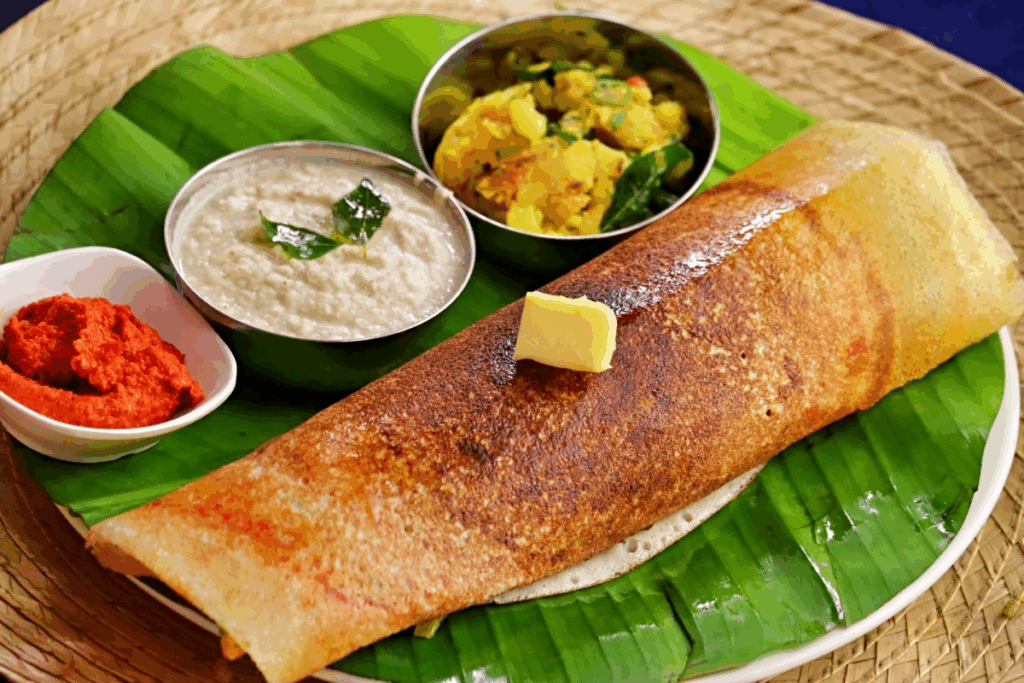
Origins and Cultural Significance of Masala Dosa
Masala Dosa has roots in the ancient kitchens of South India, especially Tamil Nadu and Karnataka. Traditionally, it’s more than just breakfast—it’s a testament to South India’s legume-rich, fermented cuisine. The popularity stems from its balance: a thin fermented lentil-rice crepe wrapped around spiced potato filling. During my travels, whether street-side in Chennai or gourmet in Bangalore, I noticed how Masala Dosa bridges generations—it’s beloved by both grandmothers and food bloggers.
Fermentation gives it a satisfying tang and airy texture, while the potato masala brings warmth and comfort. No wonder it’s now a staple in cafés, buffets, and street carts worldwide—everyone loves cracking into that crisp dosa to find fragrant potato inside.
Essential Ingredients for the Perfect Masala Dosa
From my kitchen to yours, here’s the heart of the dish:
- Rice & urad dal in a 3:1 ratio (plus fenugreek for fermentation): this gives batter body and crispness.
- Potatoes: starchy, boiled and mashed with turmeric, mustard seeds, curry leaves, and green chili.
- Onion, ginger, garlic and sometimes grated carrot: for texture and sweetness.
- Oil or ghee: used both in the potato masala and for making the dosa crispy.
- Accompaniments: sambar, coconut chutney, mint chutney—it’s the perfect combo.
In my restaurants, I always ferment the batter for 8–12 hours at a warm 30–35 °C. I’ve experimented with faster methods too—but none match the traditional slow fermentation for flavor and texture.
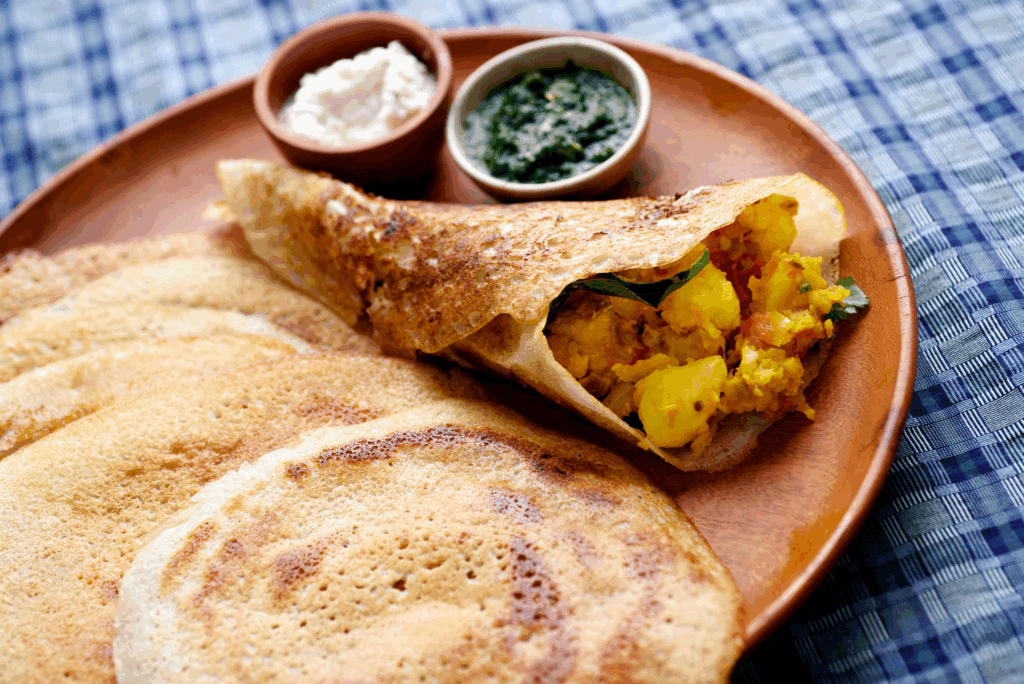
Why Masala Dosa Is a Global Favorite
The reason Masala Dosa has found fans from Mumbai to Melbourne is its universal appeal. It’s flavorful, gluten-free, and can be customized easily—vegan, spicy, mild, stuffed with paneer, cheese, or even fusion fillings like kimchi-potato.
Even sauces that go alongside Indian Pav Bhaji or drink pairings like Easy Indian Mango Lassi elevate the experience. When I host brunch, I sometimes serve dosa alongside Pani Puri shots—a playful Indian street food twist. Its sheer versatility makes it endlessly popular.
Basic Process Overview with Time Breakdown
| Task | Time Required | Notes |
| Soaking rice and dal | 4–6 hours | Use warm water for faster soaking |
| Grinding and fermenting batter | 8–12 hours | Fermentation is the magic behind crisp dosa |
| Potato filling prep | 20–25 minutes | Includes boiling, mashing, and sautéing spices |
| Cooking dosa crepes | 5–7 minutes ea. | Hot griddle, light oil, thin spread |
| Serving with sides | Immediate | Best eaten fresh alongside sambar and chutney |
This timeline helps whether you’re cooking for family breakfast or prepping for a brunch buffet. Multitasking between fermenting, mashing, and griddling is key—and totally doable.
Crafting the Dosa Batter from Scratch
Making dosa batter might sound intimidating at first, but once you understand the logic, it becomes second nature. I always use a 3:1 ratio of rice to urad dal. For rice, a mix of parboiled and raw rice gives the best texture, while split urad dal ensures fluffiness. A teaspoon of fenugreek seeds not only aids fermentation but also improves browning and flavor.
After soaking for 4–6 hours, I grind the mixture with just enough water to get a thick, smooth batter. The texture should be like pancake batter but slightly thinner. Cover the batter and let it ferment overnight in a warm place. In colder climates, I sometimes leave the batter in the oven with just the light on or wrap it in a thick towel. You’ll know it’s ready when it smells mildly sour and has doubled in volume.
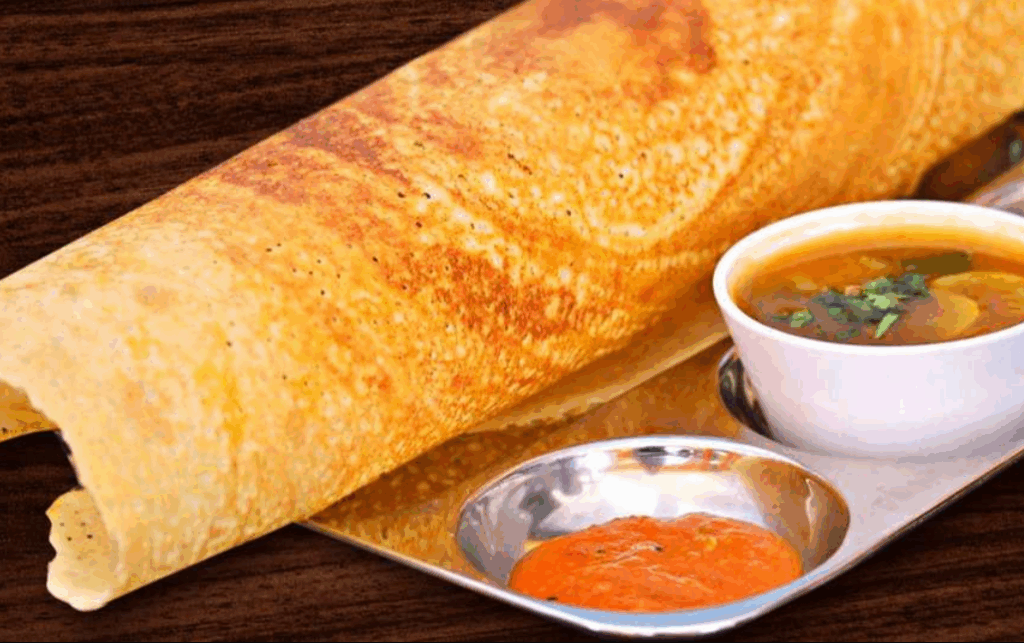
Preparing the Classic Potato Masala Filling
The filling inside the dosa is where the real flavor lives. I start by heating oil (or ghee if I want extra richness) in a pan, adding mustard seeds until they pop, then tossing in curry leaves, chopped green chilies, ginger, and sliced onions. This fragrant base builds depth.
Once the onions are soft and slightly golden, I stir in boiled, mashed potatoes and season with turmeric, salt, and sometimes a splash of water to keep it moist. Some versions use asafoetida for an extra savory kick or add peas or carrots for color and variety. I finish with a squeeze of lemon juice and fresh coriander—it balances the richness beautifully.
This same masala makes a great stuffing for sandwiches or roti wraps, or even an exciting filling for samosas. I’ve even layered it over Indian Pav Bhaji to create fusion breakfast sliders.
Cooking the Dosa on a Griddle or Non-Stick Pan
Getting that golden crisp dosa is all about heat and technique. I use a flat, cast iron tawa or a heavy non-stick pan, heated until a drop of water sizzles on contact. Then I ladle in the batter and use the back of the spoon to spiral it outward in a thin, even circle. Thinner means crisper.
A drizzle of oil or ghee around the edges helps with crisping. I cook the dosa until the underside turns golden-brown and the edges start to lift. Then I add a scoop of the potato masala in the center and fold the dosa over it—either in half or rolled like a wrap. In my kitchen, we serve them immediately with sambar and chutneys for full effect.
Serving Masala Dosa with Traditional Sides
A good dosa is only as good as its accompaniments. I always pair mine with:
- Coconut chutney: fresh grated coconut, green chili, ginger, and tempered mustard seeds
- Sambar: a lentil-based vegetable stew flavored with tamarind and spices
- Mint-coriander chutney: bright, herby, and slightly spicy
Each element balances the dosa: the creamy chutney cools the palate, the tangy sambar cuts the richness, and the masala adds savory satisfaction. If you want to really go all out, consider ending the meal with something sweet and simple like a chilled Easy Indian Mango Lassi (вставить ссылку). It’s a perfect balance of spice and coolness.
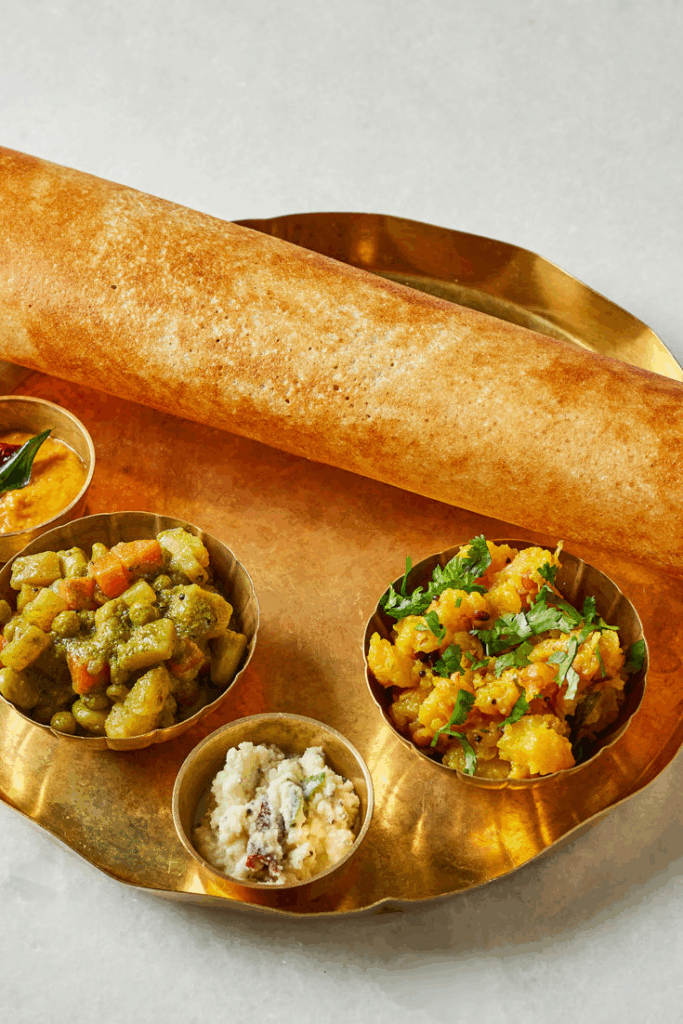
Masala Dosa Across Indian Regions
Over the years, I’ve had the chance to taste masala dosa in many regions of India, and it’s fascinating how local variations shape the experience. In Karnataka, you’ll find Benne Dosa, which is rich with butter and slightly thicker. Tamil Nadu’s version tends to be crisp and golden, often paired with spicy sambar. In Andhra, dosas might be spiked with a fiery red chutney smeared directly inside before stuffing.
In Mumbai street stalls, you’ll even find fusion creations like cheese masala dosa or schezwan dosa—an Indo-Chinese twist. My personal favorite has to be the Mysore masala dosa, with its signature red garlic chutney layer. These small regional details are why masala dosa never gets old, no matter how often I make or eat it.
Vegetarian and Vegan-Friendly Versions
The beauty of masala dosa is that it’s naturally vegetarian and easily made vegan. I use vegetable oil instead of ghee when cooking for vegan guests, and I double-check that my chutneys don’t contain yogurt. Even the potato filling can be adapted—sometimes I add sautéed mushrooms, spinach, or even tofu cubes for protein.
If you’re aiming for a fully plant-based South Indian meal, pair your dosa with a light vegan version of Indian street food: how to make Pani Puri, which balances textures in a unique and refreshing way. This contrast between crispy, creamy, spicy, and cool makes for a sensational spread.
Time and Prep Table for Masala Dosa
Here’s a clear table showing how much time you’ll need depending on the process:
| Task | Active Time | Passive Time | Notes |
| Soaking rice and dal | 10 min | 6 hrs | Overnight soaking optional |
| Grinding and fermenting batter | 15 min | 8–12 hrs | Fermentation time varies with climate |
| Making potato filling | 25 min | – | Can be made ahead |
| Cooking each dosa | 5 min | – | Best done fresh |
| Total (minimum) | ~55 min | ~14–18 hrs | Most time is passive |
As a chef, I always recommend making extra batter—it lasts for a few days refrigerated, and you can use it for idli too if you’re also planning to prepare How to make Idli and sambar at home (вставить ссылку).
Cooking Masala Dosa in Different Appliances
While a tawa is traditional, I’ve experimented with various kitchen appliances to suit modern lifestyles:
- Microwave: Not ideal for the dosa itself, but you can reheat the potato masala quickly and steam chutneys safely.
- Oven: If you preheat a pizza stone, it mimics a tawa. Use parchment and broil briefly to crisp the top, though texture won’t be identical.
- Slow Cooker: Surprisingly useful for keeping the potato filling warm and soft during large gatherings. I keep it on low while frying dosas.
- Induction cooktop: Perfect for small kitchens—just make sure your tawa is flat-bottomed and evenly heated.
The dosa batter itself can be fermented in the oven with light on, or placed in a warm corner wrapped in a cloth. I even use my Instant Pot’s yogurt setting when the weather’s cold.
Serving Masala Dosa the Traditional Way
When I serve masala dosa in my kitchen, presentation matters almost as much as flavor. The dosa is folded into a neat triangle or rolled like a crepe, revealing the golden crisp edges and a peek of spiced potato inside. I always plate it with three accompaniments: coconut chutney, tangy tomato chutney, and a piping-hot bowl of sambar.
There’s a rhythm to eating it—tear a bit of dosa, scoop some potato, dip into chutney, then alternate bites with sambar spoonfuls. For those unfamiliar with South Indian meals, this is a great time to introduce What is Indian Pav Bhaji and how to serve it as a contrasting, mashed-style comfort dish from Western India that plays just as well with bread.
Best Pairings for Masala Dosa
Masala dosa on its own is a complete breakfast or lunch, but I often create a full South Indian brunch with complementary dishes. Idlis, upma, medu vadas, and sweet kesari form a delicious spread. But for a modern touch, I recommend adding something refreshing.
One of the best pairings, especially in warmer months, is a chilled Easy Indian Mango Lassi recipe . It balances the spice and crispiness of dosa with its creamy coolness. I also sometimes serve a mini serving of poha on the side, particularly if I have leftover flattened rice from How to prepare Indian Poha breakfast. It adds variety and rounds out the meal beautifully.
Preserving and Reheating Masala Dosa
While masala dosa is best eaten fresh, there are ways to store and enjoy it later. The potato masala can be refrigerated for up to three days or frozen for longer. The batter lasts about five days in the fridge; just stir it gently before using.
Cooked dosas, however, don’t hold their texture well. If you must store them, stack them between parchment sheets and reheat on a skillet with a tiny bit of oil. Microwaving tends to make them chewy, but it works in a pinch for the filling. When planning ahead, I prefer storing the batter and masala separately—this makes everything feel fresh when finally combined.
Common Mistakes and How to Avoid Them
I’ve taught many cooks how to make masala dosa, and these are the issues I see most often:
- Batter not fermenting: It’s usually temperature-related. Keep it warm or use a fermentation setting.
- Dosa sticking to the pan: The tawa needs to be seasoned and at the right heat. Sprinkle water to test—if it sizzles and vanishes, it’s ready.
- Dosa too thick or soft: Spread the batter evenly in a spiral motion, and don’t overcrowd the pan.
- Potato filling too dry: Add a splash of water or a few tablespoons of reserved cooking water when mashing.
Correcting these missteps takes practice, but once you get the rhythm, making dosas becomes second nature.
FAQ
What type of rice is best for masala dosa batter?
From my experience, I always use parboiled rice—specifically idli rice—because it ferments beautifully and gives the dosa its signature crispness. Regular basmati or long-grain rice won’t give the same result.
Can I make dosa batter without urad dal?
I’ve tried replacing urad dal with moong dal or skipping it entirely, but the texture and flavor just aren’t the same. Urad dal provides the necessary fermentation strength and soft interior, so I recommend keeping it in.
How long should I ferment dosa batter?
In my kitchen, it takes 8–12 hours depending on the weather. I leave it near the oven or wrap it in a towel to keep it warm. If you’re in a cold area, you can even use the oven’s light or a yogurt setting.
Can I use a non-stick pan instead of a cast-iron tawa?
Yes, I’ve done this when teaching beginners. It’s easier to manage on non-stick pans, though I find the traditional cast iron gives better browning and texture. Just make sure the pan is hot and clean before pouring the batter.
Why does my dosa crack or break when spreading?
This usually means your pan is too hot or the batter is too thick. On my first few attempts, I made this mistake often. Now I always cool the pan slightly before pouring batter and make sure it spreads like thick cream.
What vegetables go well in the potato masala?
I like to add peas and sometimes finely chopped carrots. I’ve also tried spinach, grated beetroot, and even green beans. But keep it balanced—overloading it can weigh down the dosa.
Is masala dosa gluten-free?
Yes, the traditional version made with rice and urad dal is naturally gluten-free. I’ve served it to many guests with gluten intolerance, and it’s always been a safe and satisfying choice.
Can I prepare the batter in advance?
Absolutely. I prepare it in large batches, refrigerate it for up to 5 days, and use it as needed. Just stir gently before each use. If it smells too sour, it’s time to discard it.
How do I reheat leftover masala dosa?
On my experience, the skillet works best. Add a few drops of oil and gently warm it on both sides. The microwave is okay for the filling, but for the dosa itself, I avoid it—it makes it rubbery.
What should I serve alongside masala dosa?
I always serve it with coconut chutney, tomato chutney, and sambar. For a fuller breakfast spread, I might add idlis or a sweet like kesari. And of course, pairing it with Easy Indian Mango Lassi is one of my personal favorites.
Can I make mini masala dosas for kids or events?
Yes, and I do this often! Just reduce the size when pouring the batter. They make great finger food at parties, and kids love them with ketchup or mild coconut chutney.
Is masala dosa healthy?
In moderation, yes. It’s made from fermented rice and lentils, with a filling of potatoes and spices. I make it healthier by using less oil and adding vegetables. It’s protein-rich, gluten-free, and quite balanced if not overloaded with ghee.
Can I freeze dosa batter?
I’ve frozen it in silicone muffin molds and defrosted small portions as needed. It works surprisingly well. Just thaw it completely, stir, and allow it to sit for 30 minutes before using.
What’s the difference between masala dosa and plain dosa?
Plain dosa is just the fermented crepe without any filling. Masala dosa includes a spicy potato filling, which adds heartiness and flavor. I often serve both, giving guests a choice.




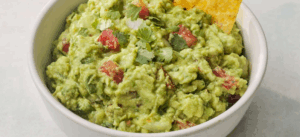
Post Comment